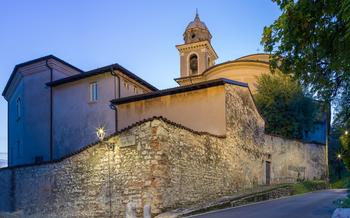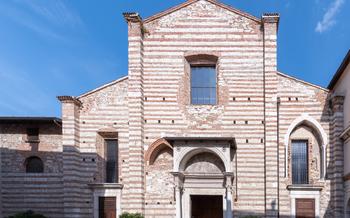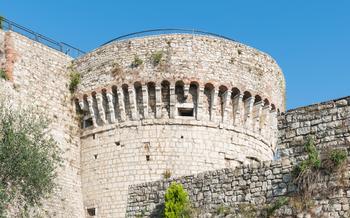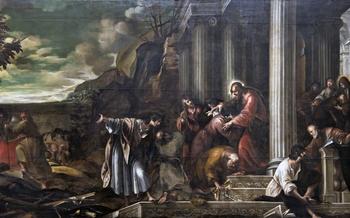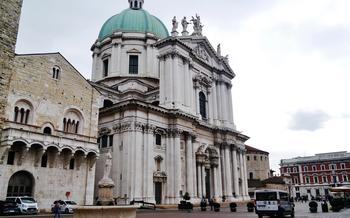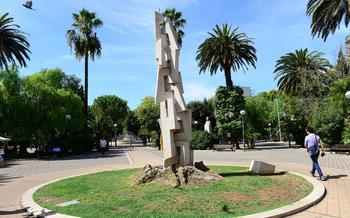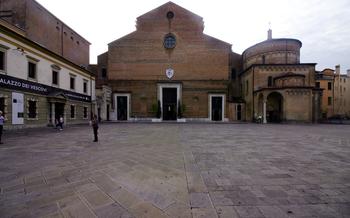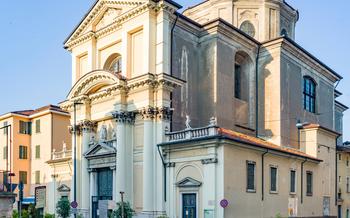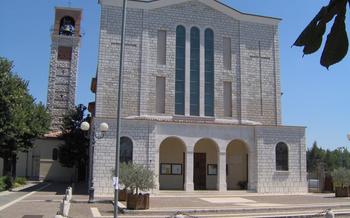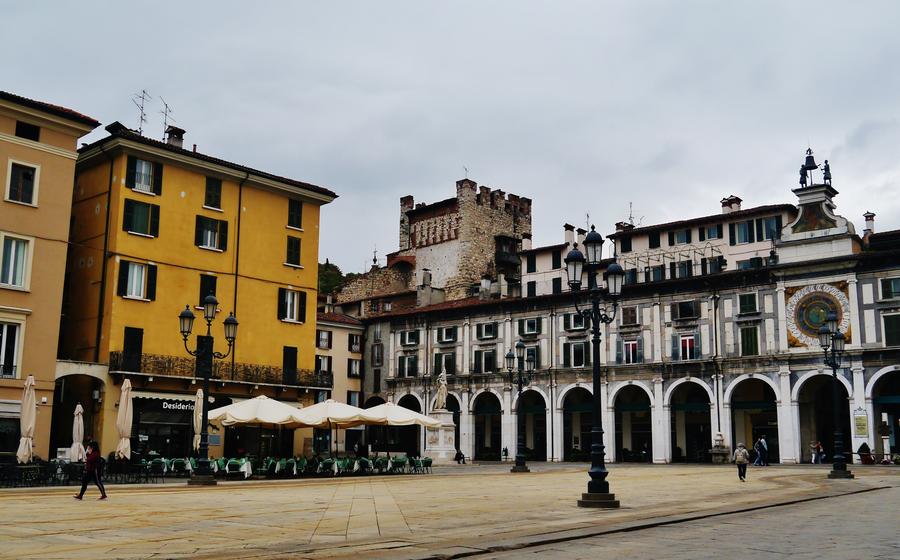
Piazza della Loggia
- Piazza della Loggia: The Historical Heart of Brescia
- Historical Significance - The Roman City
- Architectural Masterpieces - The Loggia
- The Column of Victory - A Symbol of Triumph
- Monte di Pieta - Banking through the Centuries
- Palazzi of Piazza della Loggia - Architectural Gems
- Torre dell'Orologio - Timekeeper of Brescia
- Cappella del Santissimo Sacramento - Sacred Beauty
- Piazza della Loggia: A Journey Through Brescia's Past
- Santa Giulia Museum - A Cultural Treasure
- Piazza della Loggia Today - A Vibrant Square
- Hidden Gems - Exploring Beyond the Main Square
- Local Flavors - Culinary Delights:
- Special Events and Festivals
- Insider Tip - Photo Ops and Panoramic Views:
Piazza della Loggia: The Historical Heart of Brescia
In the heart of Brescia, a city steeped in history and architectural wonders, lies Piazza della Loggia, a majestic square that serves as a testament to the city's rich heritage. Once a political and social hub of the ancient Roman town known as Brixia, the piazza has witnessed the passage of time, evolving into a symbol of Brescia's cultural legacy.
Over the centuries, Piazza della Loggia has been adorned with stunning architecture, each building contributing to its unique charm and grandeur. From the elegant Loggia, a Renaissance masterpiece, to the Column of Victory, commemorating Brescia's triumph over Venetian rule, the square is a treasure trove of historical and artistic significance.
As you stroll through Piazza della Loggia, you'll be surrounded by architectural masterpieces that showcase the city's artistry and craftsmanship. The intricate carvings, detailed stonework, and elegant arches tell a story of Brescia's glorious past, inviting you to explore the rich history that unfolds within this captivating square.
Historical Significance - The Roman City
Brescia's roots trace back to ancient Roman origins, a period that significantly influenced the city's history and growth. During the Roman era, Brescia, known as Brixia, flourished as a prosperous town on the Via Gallica, a key trade route connecting Italy with northern Europe. Evidence of Roman presence can be found in the numerous ruins and artifacts unearthed in the area, preserving the legacy of this significant era. Piazza della Loggia, in particular, was a central point in ancient Brixia, serving as a hub for political, social, and economic activities. Its historical significance as the heart of the ancient Roman city adds depth and context to the piazza's rich and storied past.
Architectural Masterpieces - The Loggia
The centerpiece of Piazza della Loggia, the Loggia, is an architectural masterpiece that embodies the elegance and grandeur of the Renaissance period. Constructed in the 15th century by renowned architects, this magnificent structure boasts intricate stonework, elegant arches, and intricate carvings. Each detail reflects the artistic prowess and craftsmanship that characterized Brescia during the Renaissance.
The Loggia's harmonious lines and refined decorations showcase the influence of classical architecture and the transition from Gothic to Renaissance styles. Its elegant facade features a series of arches supported by slender columns, creating a graceful and airy effect. The intricate bas-reliefs and sculptures adorning the facade depict historical scenes and allegorical figures, adding depth and narrative to the building's design.
The Loggia served as a gathering place for the city's elite and a venue for important civic events. Its spacious interior provided a grand setting for meetings, ceremonies, and celebrations. Today, the Loggia continues to be a symbol of Brescia's artistic heritage and a testament to the city's enduring architectural legacy.
The Column of Victory - A Symbol of Triumph
Amidst the architectural wonders of Piazza della Loggia, the Column of Victory (Colonna della Vittoria) stands tall as a symbol of Brescia's triumph over Venetian rule. Erected in 1608 amidst tears of joy and roars of triumph, the column commemorates the city's hard-fought victory in 1512, when Brescia finally broke free from Venetian domination after many years of struggle.
The column's artistic and architectural features are a testament to the city's pride and gratitude. Its intricate carvings and elegant lines showcase the skill and artistry of the era's master craftsmen. The column is crowned by the majestic winged lion of St. Mark, the symbol of Venice, a reminder of the city's newfound freedom and sovereignty.
The Column of Victory holds immense cultural significance for Brescia. It embodies the city's resilience, determination, and unwavering spirit in the face of adversity. As a symbol of Brescia's independence and fortitude, the column stands as a reminder of the city's rich history and its enduring legacy of triumph over adversity.
Monte di Pieta - Banking through the Centuries
Established in 1483, the Monte di Pieta is a historical banking institution deeply rooted in the social fabric of Brescia. Its primary mission was to provide financial assistance and charitable services to the city's residents, particularly those in need. The institution's founding principles emphasized compassion, fairness, and the betterment of the community.
The Renaissance-style building that houses the Monte di Pieta is a testament to the institution's significance. Its elegant facade features intricate stone carvings, arched windows, and a grand entrance that invites visitors to step into a world of history and tradition. Inside, the building's spacious halls and vaulted ceilings exude an aura of reverence and trustworthiness.
Over the centuries, the Monte di Pieta has played a pivotal role in Brescia's economic and social development. It pioneered innovative banking practices, such as lending money on the security of pledged goods and offering interest-free loans to the poor. These practices not only provided financial relief to individuals but also contributed to the growth of commerce and trade in the city.
Today, the Monte di Pieta stands as a symbol of Brescia's rich banking heritage and its enduring commitment to social responsibility. It continues to operate as a financial institution, offering a range of services to the community while maintaining its core values of compassion and support. A visit to the Monte di Pieta is a journey through time, allowing visitors to appreciate the enduring legacy of this remarkable institution.
Palazzi of Piazza della Loggia - Architectural Gems
Surrounding Piazza della Loggia, an array of palazzi stand as testaments to Brescia's architectural heritage. Palazzo del Broletto, with its imposing Gothic facade, served as the seat of civic government in the Middle Ages. Palazzo della Mercanzia, showcasing Renaissance elegance, was once the hub of trade and commerce. Palazzo Comunale, adorned with Baroque grandeur, represents the city's modern administrative center. Each palazzo reflects the changing architectural styles that shaped Brescia over the centuries.
Palazzo del Broletto, the oldest among them, exudes a sense of power and authority with its crenellated tower and intricate stonework. Built in the 12th century, it has undergone several renovations, blending Gothic elements with Renaissance influences. Its grand halls once hosted important political gatherings and trials.
Palazzo della Mercanzia, constructed in the 15th century, embodies the thriving commercial spirit of Brescia. Its graceful Renaissance facade features elegant loggias, delicate carvings, and ornate windows. Inside, the Sala delle Mercanzie, with its coffered ceiling and frescoes, served as a meeting place for merchants and traders.
Palazzo Comunale, the city's modern-day town hall, was built in the 17th century. Its opulent Baroque facade, characterized by sweeping curves and elaborate ornamentation, reflects the grandeur of the era. The grand staircase, adorned with frescoes depicting scenes from Brescia's history, leads to the Sala del Consiglio, where important decisions are made.
Together, these palazzi form an architectural ensemble that showcases the diverse styles that have shaped Brescia's urban landscape. They stand as symbols of the city's rich history, power, and cultural heritage, inviting visitors to delve into the stories they hold.
Torre dell'Orologio - Timekeeper of Brescia
In the heart of Piazza della Loggia, the Torre dell'Orologio stands tall, a proud symbol of Brescia's passage of time. Constructed in the 15th century, this clock tower blends Gothic and Renaissance architectural elements, showcasing the city's rich artistic heritage.
The tower's intricate design features a series of arches and windows, adorned with intricate carvings and sculptures. The clock face, created by renowned clockmaker Giovanni Antonio Avogadro, is a masterpiece of craftsmanship, displaying the hours, minutes, and even the phases of the moon.
Throughout the centuries, the Torre dell'Orologio has served as a meeting point and a symbol of civic pride for the people of Brescia. Its bell tolls the hour, marking significant moments in the city's history and daily life.
As the sun sets over Piazza della Loggia, the tower's silhouette casts long shadows across the square, creating a mesmerizing play of light and shadow. Locals and visitors alike gather beneath the tower, admiring its beauty and reflecting on the rich history it represents.
Whether admiring its architectural details, marveling at the intricate clock face, or simply soaking in the atmosphere, the Torre dell'Orologio is a must-see landmark that offers a glimpse into the soul of Brescia.
Cappella del Santissimo Sacramento - Sacred Beauty
Within the vibrant Piazza della Loggia lies a hidden gem that encapsulates the spiritual essence of Brescia - the Cappella del Santissimo Sacramento. This intimate chapel, dedicated to the Holy Sacrament, exudes an aura of reverence and tranquility amidst the bustling square. Step inside and be captivated by the intricate frescoes that adorn its interior, particularly the stunning ceiling masterpiece by the renowned Lattanzio Gambara. The chapel's history is deeply intertwined with the religious life of Brescia, serving as a sacred space for centuries. Discover the stories and legends that surround this chapel, and experience the profound sense of spirituality that permeates its every corner.
Piazza della Loggia: A Journey Through Brescia's Past
Santa Giulia Museum - A Cultural Treasure
Within a short stroll from the bustling Piazza della Loggia, travelers can immerse themselves in Brescia's rich history at the Santa Giulia Museum. Housed in a former Benedictine monastery, this cultural treasure takes visitors on a journey through the city's past, from its Roman origins to modern times.
The museum's diverse collections showcase archaeological finds, medieval artifacts, and the remains of an ancient Roman basilica, offering a glimpse into Brescia's layered history. Among the highlights is the captivating collection of Romanesque and Gothic sculptures, including the famous "Victory of Brescia," a bronze statue that symbolizes the city's triumph over its enemies.
Visitors can wander through the atmospheric cloisters, admiring the graceful arches and intricate frescoes that adorn the walls. The museum's collection of paintings spans centuries, featuring works by local masters such as Moretto da Brescia and Giovanni Battista Moroni, whose vibrant canvases capture the essence of Brescia's artistic heritage.
The Santa Giulia Museum is not just a repository of artifacts; it's a place where history comes alive. Interactive exhibits and multimedia displays bring the past to life, allowing visitors to engage with Brescia's story in a dynamic and immersive way.
Whether you're a history buff, an art enthusiast, or simply curious about Brescia's cultural roots, the Santa Giulia Museum is a must-visit. Its treasures offer a profound insight into the city's evolution, making it an essential stop on any journey through Piazza della Loggia and beyond.
Piazza della Loggia Today - A Vibrant Square
Today, Piazza della Loggia is a bustling square, a lively gathering place for locals and visitors alike. The square is lined with restaurants, cafes, and shops, creating a vibrant social hub. Regular events, markets, and activities are held in the piazza, showcasing its versatility. It is a place to relax, soak in the atmosphere, and experience contemporary Brescia. The square's lively atmosphere is palpable, with the sounds of people chatting, the clinking of glasses, and the laughter of children filling the air. Street performers often entertain the crowds, adding to the lively ambiance. Piazza della Loggia is a place to see and be seen, and it is a great place to get a sense of the city's vibrant energy.
Hidden Gems - Exploring Beyond the Main Square
Venture beyond the main square to discover the hidden gems that lie just steps away from Piazza della Loggia. Explore the intricate alleyways and charming streets that lead to hidden courtyards, historic churches, and art galleries. Admire the stunning architecture of the Palazzo Martinengo and the Palazzo Tosio, which house museums showcasing Brescia's rich art and history.
Stumble upon unique boutiques and artisan workshops where local artisans create exquisite ceramics, jewelry, and other handcrafted treasures. Indulge in traditional Brescian cuisine at hidden trattorias and ristoranti, where the aromas of homemade pasta, grilled meats, and fresh produce fill the air.
As you wander through these lesser-known corners of Brescia, you'll uncover a side of the city that is both authentic and enchanting. Embrace the opportunity to get lost in the labyrinthine streets and discover the hidden gems that make Brescia such a captivating destination.
Local Flavors - Culinary Delights:
Piazza della Loggia is a culinary haven, offering a tantalizing array of traditional Brescian dishes. Indulge in the flavors of casoncelli, delicate pasta pockets filled with minced meat, vegetables, and cheese, served in a sage-infused butter sauce. Savor the smoky goodness of spiedo bresciano, succulent skewers of grilled meats, cooked over an open fire and seasoned with local herbs and spices. For a taste of simplicity, try manzo all'olio, a tender beef stew slow-cooked in olive oil, white wine, and aromatic herbs.
Brescian cuisine celebrates regional ingredients and seasonal produce. Local farmers and artisans take pride in their craft, ensuring the highest quality of products. Whether you prefer fine dining experiences or casual trattorias, you'll find culinary treasures around every corner of Piazza della Loggia. Embrace the slow food philosophy and savor the authentic flavors that have been passed down through generations. As you relish each bite, you'll discover the true essence of Brescia's rich culinary heritage.
Special Events and Festivals
Throughout the year, Piazza della Loggia comes alive with special events and festivals that showcase Brescia's vibrant culture and heritage. The Brescia Summer Festival, held annually during the warm summer months, transforms the piazza into a stage for music, theater, and dance performances. International and local artists come together to create a magical atmosphere as the square resonates with music, laughter, and applause.
Traditional festivals such as the Festa del Perdono and the Brixia Mille Miglia also find their home in Piazza della Loggia. The Festa del Perdono, celebrated on the first Sunday of September, is a religious festival that features a procession carrying the statue of the Madonna della Pace through the streets of Brescia. The Brixia Mille Miglia, on the other hand, is a historic car race that takes place annually, attracting vintage car enthusiasts from around the world. The race passes through Piazza della Loggia, allowing spectators to admire the classic cars and experience the thrill of the competition.
These special events and festivals not only add vibrancy to the piazza but also offer a unique opportunity for visitors to immerse themselves in Brescia's rich cultural traditions and festive spirit. Whether it's enjoying a live performance, witnessing a historic race, or simply soaking in the lively atmosphere, Piazza della Loggia becomes a hub of celebration and cultural exchange during these special occasions.
Insider Tip - Photo Ops and Panoramic Views:
To fully capture the beauty of Piazza della Loggia, don't miss the opportunity to climb the Torre del Pegol, a historic tower that offers breathtaking panoramic views of the entire square and the surrounding cityscape. From this elevated vantage point, you can take in the architectural details of the buildings, the vibrant atmosphere of the piazza, and the stunning backdrop of the Alps in the distance. Whether you're a professional photographer or simply an enthusiastic traveler, the Torre del Pegol provides the perfect opportunity to capture Instagram-worthy shots that will showcase the essence of Brescia. So make sure to add this insider tip to your itinerary to experience the piazza from a unique perspective and create lasting memories of your visit.
